Eight is a magic number for Magic players—at most premier level tournaments, being in the Top 8 is the difference between success and relative failure (new, perplexing exception: Grand Prix). Coincidentally, it has been eight weeks since Dark Ascension became legal for Standard play and has influenced the outcomes of the StarCityGames.com Open Series tournaments. Now seems like an excellent time to examine trends and successes across those eight weeks to see if we can use the evolution of the format to assist Magic players hoping to make it big in Salt Lake City.
In the last eight weeks, an amazing 27 different archetypes have made the Top 16 of a SCG Open Series tournament (I don’t include data from the Invitational because it’s likely that two factors—the combined format placing and the average strength of the players—may bias deck selection relative to a typical tournament). The first step in looking at the format longitudinally is to document the average finish of each deck and the number of decks of each type that have finished in the Top 16 each week. The table appears below:
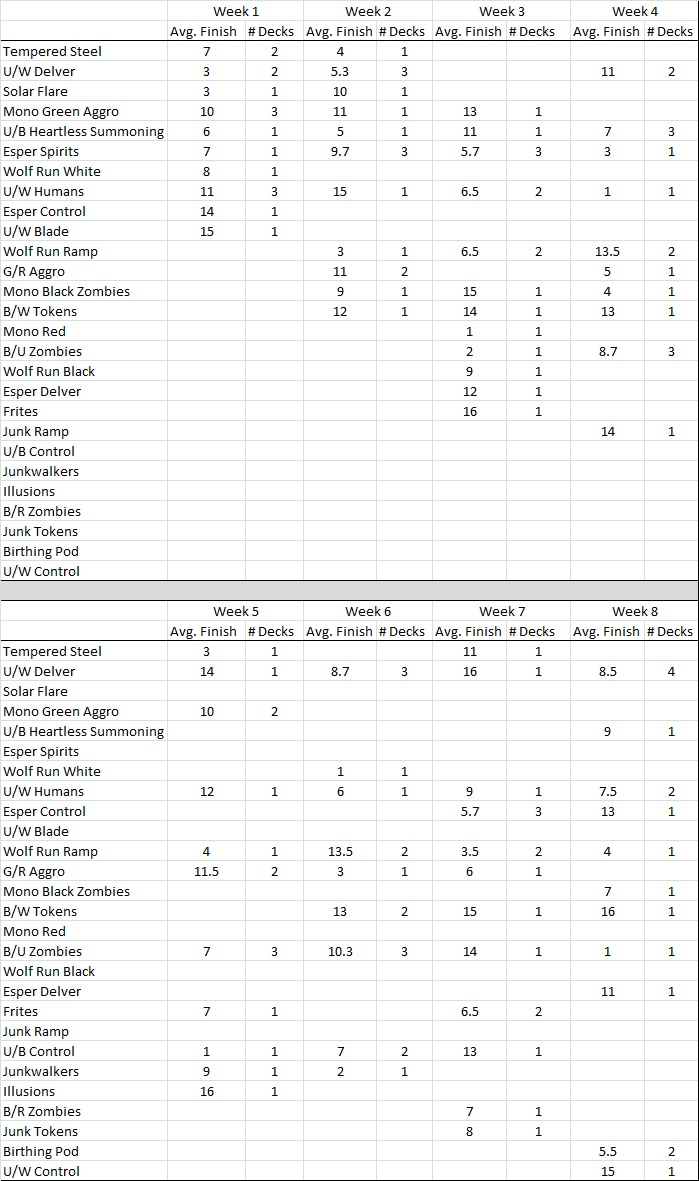
Before we go on, it’s worth noting that this type of table gives us a great visualization of how new technology integrates itself within the tournament structure. In the image below, the teal space indicates all of the potentially viable decklists that had not yet been played or fine-tuned to the extent that they could make the Top 16 in an environment with Dark Ascension. (Granted, there are numerous other factors that might influence appearances in the Top 16; for example, Wolf Run Ramp was very established in week 1 but did not have a Top 16 placing—perhaps this indicates everyone’s interest in trying new strategies.)
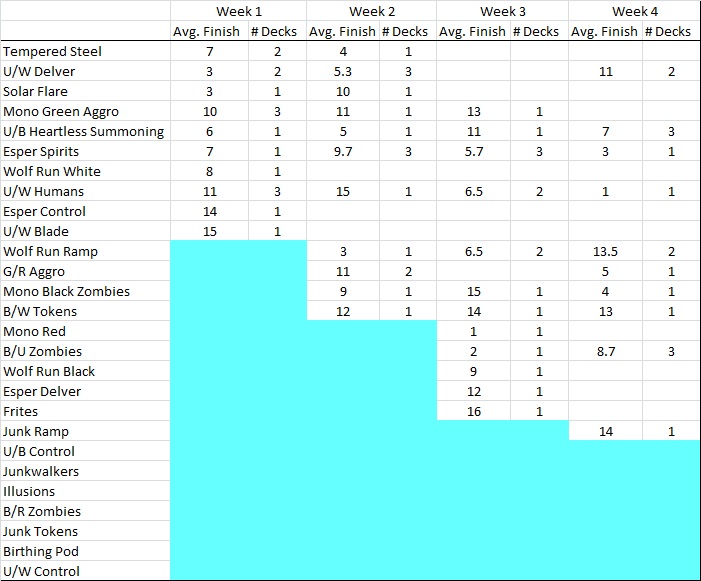
We see that the integration of new successful decks into the tournament environment following the release of the new set is fairly pronounced at first and then tapers off a bit as the format matures. We also see from the first table that decks often vanish from the format as they become less suited to the metagame, and then re-emerge when conditions are favorable (a basic principle of metagaming). However, this data isn’t quite as informative as we would like in terms of understanding or mapping trends.
We might consider graphing the average finish of decks over time, but this unfairly “penalizes” decks that have a high-placing finish in the Top 16 as well as a lower-placing finish (i.e., 2nd place and 15th place). In order to address this issue, we might consider tracking only the highest-placing finish, but this ignores the density of finishes. For example, a deck that places 8th, 9th, 10th, and 16th would have a worse rating than a deck that placed 3rd, but it might have been a better overall choice for that tournament.
As a compromise, I’ve provided data in the graph below that approximates “deck strength” for a given tournament. This is simply average finish/number of decks, where a lower number indicates a more potent strength. A 1 is the best possible score and a 16 is the worst. Bear in mind two things: first, this method may still overstate the strength of a lone deck that wins a tournament or that places well, though it does so to a lesser extent than simply reporting the highest finish per week. Second, all of the decks listed herein made the Top 16 so none were “bad” choices for that given week—a score of 16 is worse only relative to the rest of the Top 16, not relative to the tournament as a whole.
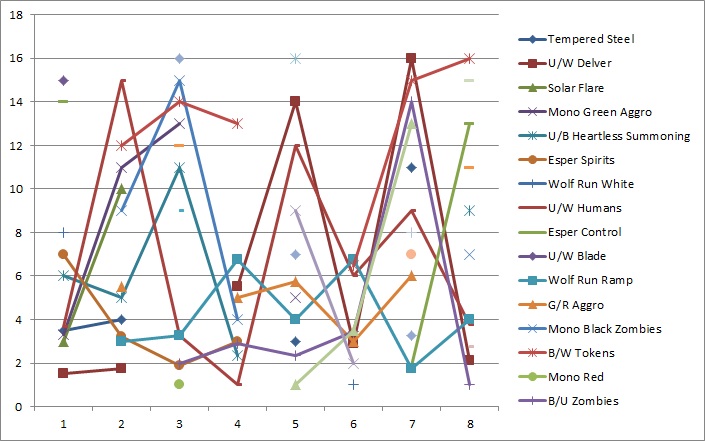
This is a lot of data to examine at once, but I’ve included it here because it illustrates the sheer complexity of the current Standard metagame (one that seems to be quite healthy, although if it is “solved” it will begin to stagnate). In order to improve our ability to view results, I’ve broken the graph into several segments. Examination of this data is not statistical in nature because the sample sizes are rather small, but observation of longitudinal patterns can still be of inductive use.
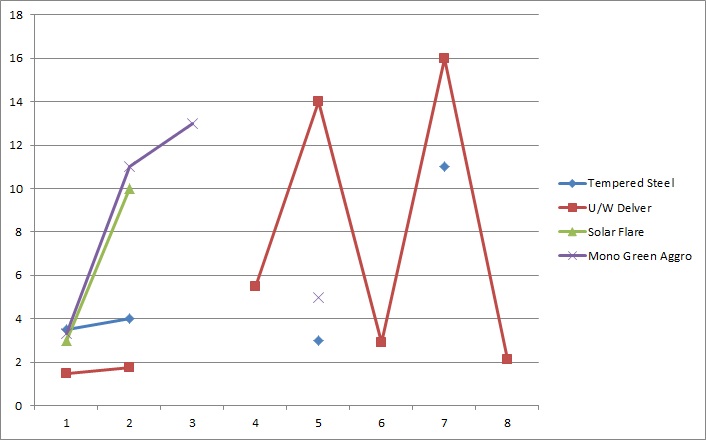
In this graph we see Solar Flare, Mono-Green Aggro, and Tempered Steel start fairly strong but taper off by week 3, with Tempered Steel making occasional showings afterward but never for two weeks in a row. U/W Delver was a strong choice initially, then vanished briefly, and now has established a fairly consistent pattern as a serious contender.
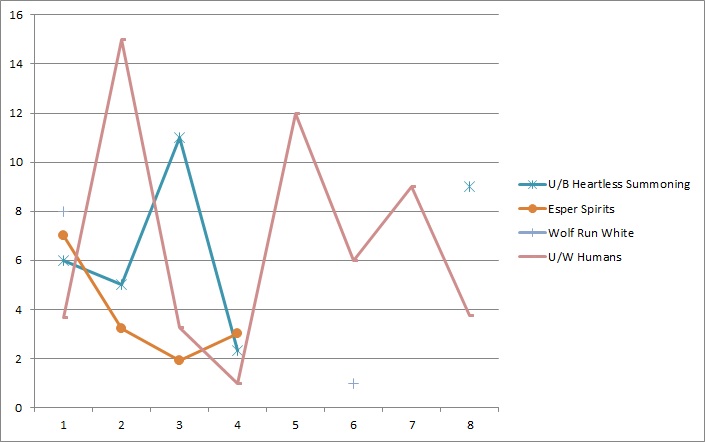
Wolf Run White has appeared twice, once winning the entire tournament, but has not been a consistent player. U/B Heartless Summoning (with and without Havengul Lich) made the Top 16 four weeks in a row and then vanished until last week. Esper Spirits started strong but vanished after week 4 (and may have become conflated with Delver decks), while U/W Humans has been a consistent contender across all eight weeks.
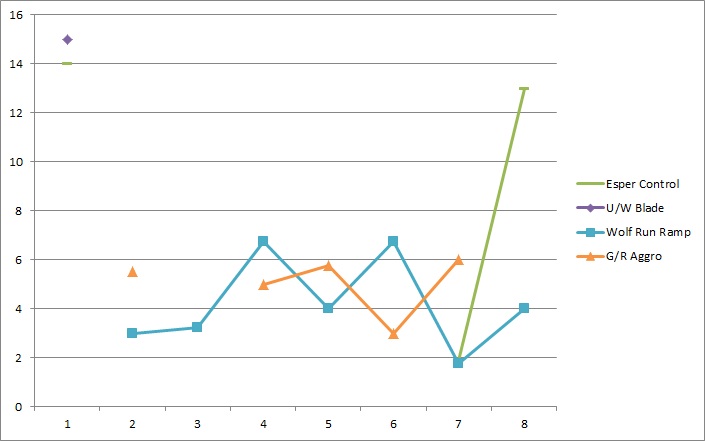
The most interesting aspect of this graph, we might think, is that although Wolf Run Ramp surprisingly was absent in week 1 (again, it might have been due to the “oooh shiny” phenomenon following the release of Dark Ascension), it has had a deck strength better than the mid-point (8) every subsequent week. If we look at this data in combination with data from Wolf Run White, it seems as though Primeval Titan, though less frequently “in the press” than Delver of Secrets, is a very serious, consistent contender for the Top 16. G/R Aggro also seems like a reasonable choice and may have supplanted Mono-Green Aggro, though it did not place in last week’s tournament.
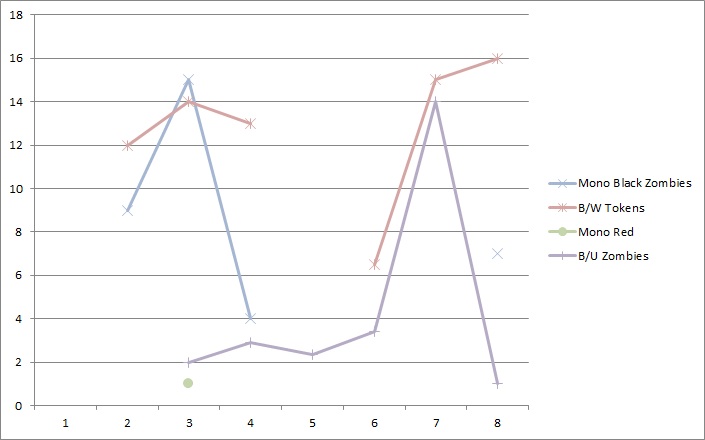
Here we see the tragedy that is Sorin, Lord of Innistrad—often the groomsman, never the groom. While B/W Tokens frequently has registered on the “strength” metric, it has never had a score better than 6, suggesting that it may be a reasonable choice to have an outside chance at the Top 16 but likely will not win a SCG Open Series without significant alters to its structure. We also see that Zombies, both Mono-Black and U/B, is a serious contender, not only in the strength of its finishes but in terms of its consistency over time.
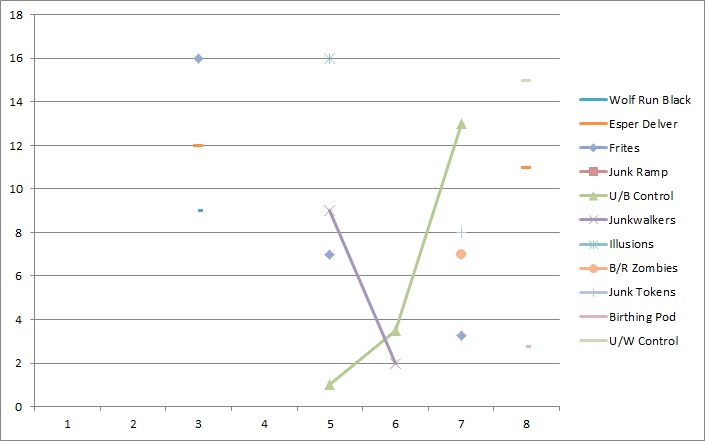
Finally, we see the variety of niche archetypes that have made Top 16 more recently, including the seemingly strong Birthing Pod decks (both Naya and Four-Color). Because these lists, especially Birthing Pod, are new, it’s difficult to tell how consistently they will perform, but Naya Pod seems to be a legitimate contender. In addition, we see that U/B Control has established a longitudinal place in the metagame and is the current go-to control archetype, although it didn’t place in week 8.
Interestingly, if we look at strength trends over time, it appears as though the “big six” archetypes, U/W Delver/Esper Spirits, U/W Humans, G/R Aggro, Zombies, U/B Control, and Wolf Run Ramp undergo alternating increases and decreases in strength. Furthermore, the weeks where U/W aggro decks increase in strength are the weeks where Wolf Run Ramp decreases and vice versa. If this trend continues, then Wolf Run Ramp will have a better weekend in Salt Lake City than U/W Delver even if it’s not necessarily the better deck. This also doesn’t mean that there will be fewer copies of the aggressive decks, and it doesn’t account for Zombies or R/G Aggro, both of which are contenders.
Based on this data, if I were playing in Salt Lake City I’d play Wolf Run Ramp crammed with maindeck removal and with a sideboard designed to blow apart the mirror match. Justin Gottlieb’s deck from the SCG Standard Open last week in Baltimore is an excellent start, though we might consider adding a second maindeck Whipflare. We might also consider an additional Karn Liberated in the sideboard, bringing the total to three, to combat the potentially increased density of well-performing ramp decks. Batterskull may be another potentially viable answer to the current slew of well-performing aggressive decks, and, to the extent that we expect to see more copies of Birthing Pod, a second Ancient Grudge might be warranted especially since it targets a number of other relevant threats.
Good luck this weekend in Salt Lake City!
